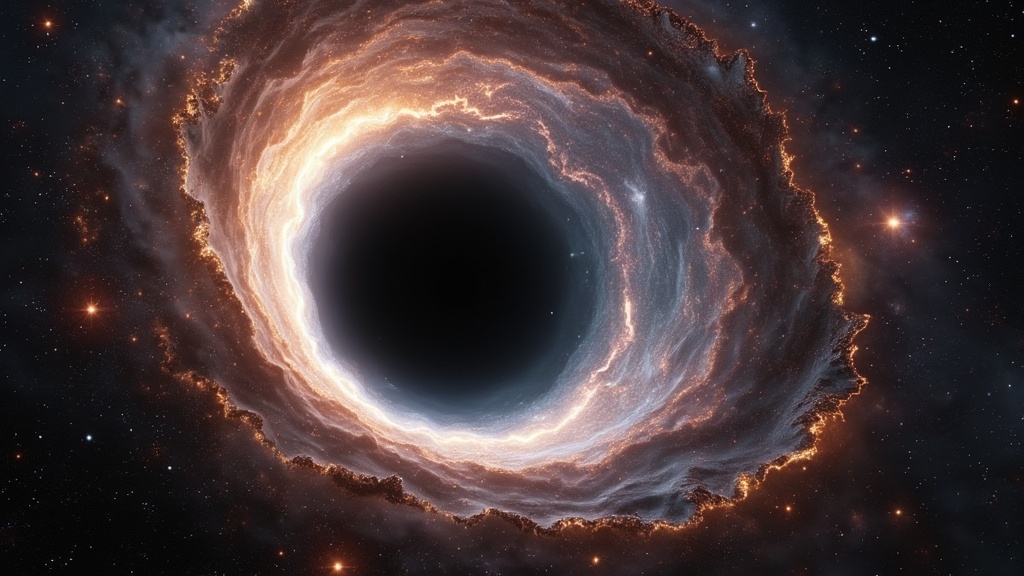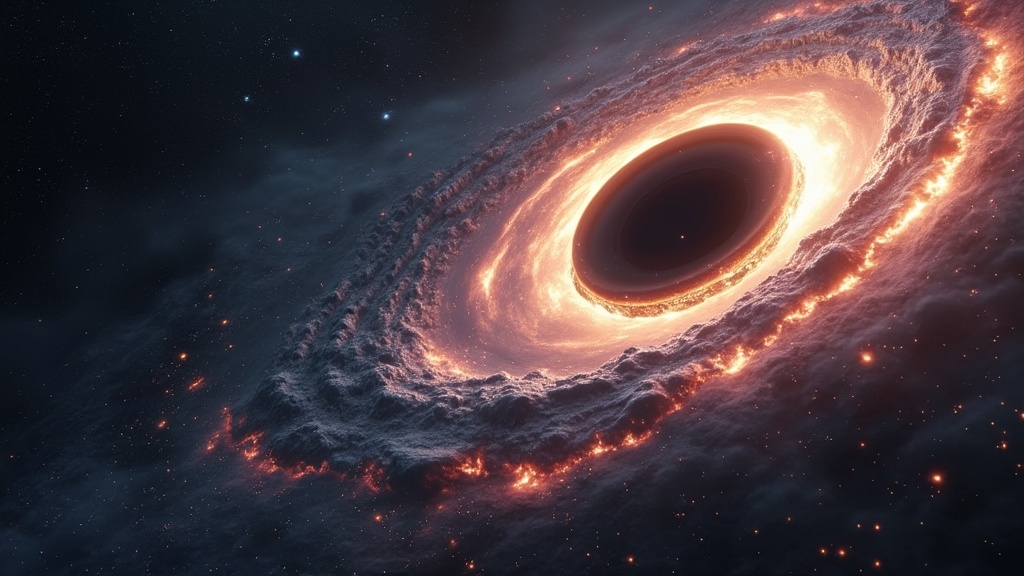
The mysterious nature of black holes fascinates scientists across the globe. While often perceived as cosmic vacuum cleaners, black holes demonstrate a more intricate interaction with their environment.
These astronomical entities warp the SpaceTime continuum, creating gravitational fields where time distorts in remarkable ways.
Einstein’s equations forecast these relativistic effects, especially evident near massive bodies such as black holes.
Delving deeper into these cosmic phenomena uncovers a universe where gravity and time form a dynamic interplay, setting the stage for paradoxical experiences that challenge our perception of reality.
Black Hole Formation and Cosmic Evolution
Black Hole Formation heralds a dramatic transformation in the universe. It begins with the gravitational collapse of massive stars, leading to the emergence of stellar remnants and the birth of black holes.
A singularity forms at the core, providing insights into the fundamental workings of space-time and quantum field theory. This process challenges our understanding of Einstein’s legacy and demands new perspectives on the universe’s architecture.
- Gravitational Collapse: Massive stars undergo catastrophic implosion.
- Stellar Remnants: Neutron stars are left behind, often paving the way for black holes.
- Cosmic Evolution: Black holes influence the cosmic microwave background and contribute to universe expansion.
Through these celestial phenomena, black holes act as powerful engines driving galactic cosmic evolution. They facilitate universe expansion, shape galaxies, and introduce new frontiers in physics. The interaction between dark energy and black holes reveals deeper layers of the universe’s complexity, guiding astronomers toward solving the universe’s greatest cosmic mysteries.

How Does Hawking Radiation Affect Black Holes
Hawking Radiation emerges when Quantum Fluctuations near the event horizon lead to the emission of Virtual Particles. This intricate phenomenon closely interacts with the Photon Sphere, a region where light orbits due to intense gravity.
Such Relativistic Effects amplify Hawking Radiation’s impact by facilitating gradual mass loss in black holes.
For instance, microscopic black holes gradually evaporate, underscoring theoretical implications on their lifespans.
These dynamics unveil a deeper connection between Hawking Radiation and the evolution of Cosmic Phenomena. By exploring these processes, we gain insights into how radiation shapes the broader SpaceTime Continuum.
Exploring Singularity And SpaceTime Warping
Singularity presents a profound Cosmic Mystery that tests the boundaries of known physics.
Einstein’s Equations often break down in these extreme conditions, especially at black holes’ cores. This illustrates the limitations of current theories.
SpaceTime Warping occurs as massive objects bend the fabric of space, a concept observable in the correction of GPS satellite data to account for such distortions.
Gravitational Collapse plays an integral role, leading to Black Hole Formation and enhancing these warping effects.
Together, these phenomena propel our comprehension towards uncharted realms and pave the way for revolutionary insights into the SpaceTime Fabric.
Black Holes and SpaceTime
- Hawking Radiation leads to the gradual evaporation of microscopic black holes.
- Quantum Fluctuations near the event horizon cause the emission of Virtual Particles.
- SpaceTime Warping is evidenced by the need to correct GPS satellite data for gravitational distortions.
- Einstein’s Equations often fail in the extreme conditions of a singularity.
Gravitational Collapse: A Cosmic Phenomenon
The phenomenon of gravitational collapse is central to the universe’s cosmic evolution, serving as a key process in the creation of neutron stars. Einstein’s equations are essential here, offering precise models of massive stars during their implosion.
When a star’s core surpasses its critical mass, it experiences a powerful inward collapse.
Identifying gravitational collapse involves detecting specific radiation signals, which astronomers use as indicators.
This knowledge forms a bridge to Einstein’s equations and their role in understanding the universe’s spacetime continuum.
Understanding Einstein’s Equations And Relativistic Effects
Spacetime Warping and Singularities
Einstein’s equations provide deep insights into the warping of the spacetime fabric. By examining gravitational interactions, scholars reveal how massive objects, such as stars, bend spacetime, forging complex paths known as geodesics.
The study of gravitational collapse further enhances our comprehension of these cosmic mysteries.
Examples of Relativistic Effects
A profound example of relativistic effects is observable in time dilation. Near the event horizon of black holes, time appears to slow dramatically.
This phenomenon highlights how such cosmic principles influence structures like neutron stars and the universe.
The understanding of these interactions ties back to Einstein’s legacy, demonstrating his equations’ far-reaching impact.
Gravitational Collapse and Relativity
- Gravitational collapse is crucial for the formation of neutron stars.
- Einstein’s equations model the implosion of massive stars.
- Specific radiation signals are used to detect gravitational collapse.
- Time dilation near black holes illustrates relativistic effects.
Neutron Stars And Their Gravitational Interaction
Neutron stars, some of the most fascinating cosmic phenomena, engage in complex gravitational interactions. These dense remnants are formed from the core collapse and gravitational collapse of massive stars in supernova explosions, transforming the space-time fabric around them.
Accretion disks surrounding neutron stars are crucial in this process, feeding them with gas, which contributes to the intense relativistic effects observed.
These effects include light bending and frame dragging, akin to a cosmic ballet of gas and radiation.
The elusive photon sphere emerges as a pivotal feature, where light barely escapes the gravitational grip of neutron stars, allowing radio telescopes to detect their presence.
A useful tip for aspiring astronomers is to observe these interactions through radio emissions, as they surpass the interference of cosmic microwave background radiation and reveal the gravitational interactions at play.
What Is The Photon Sphere In Black Holes
Among the cosmic mysteries of the universe, the photon sphere is an intriguing region around black holes where gravity is intensely strong, marking a boundary that photon particles dare not cross. Its relevance extends beyond light trapping; it intertwines with Hawking radiation, a phenomenon predicted by Hawking’s Theory, suggesting that radiation can emerge from the black hole’s horizon due to quantum fluctuations and thermal effects.
Space-time warping, a feature of Einstein’s equations, plays a significant role here.
It enables light to bend and form gravitational lenses, impacting our observations from Earth. The Event Horizon Telescope, a marvel of modern astrophysics, captured the first image of a black hole’s shadow, providing tangible evidence of the photon sphere’s influence on this singularity, nestled within the space-time continuum.
Neutron Stars and Photon Spheres
- Neutron stars are formed from the core collapse of massive stars during supernova explosions.
- Accretion disks around neutron stars contribute to the intense relativistic effects observed.
- The photon sphere is a region around black holes where gravity is strong enough to trap light.
- Hawking radiation is related to quantum fluctuations and thermal effects near black holes.
Exploring The Accretion Disk And Its Role
Accretion disks serve as the vibrant arenas where gravitational forces perform their complex dance, playing a significant part in black hole formation. Formed through gravitational collapse, these disks meticulously guide material into black holes while emitting powerful radiation.
This dynamic process is central to cosmic evolution, demonstrating how black holes draw in surrounding matter, thereby influencing the universe’s grand tapestry.
A notable example includes the overwhelming brightness of quasars, an illumination driven by these very mechanisms.
Insights gleaned from these interactions significantly enhance our understanding of growth patterns within black holes, shedding light on their profound impact on the universe’s structure and behavior.
How Does The Universe Expansion Impact Black Holes
Cosmic phenomena such as universe expansion exert a substantial influence on black hole formation. As the universe expands, it redistributes matter, which in turn affects the size and growth rate of black holes.
Studies on Hawking radiation unveil fascinating implications, suggesting the possibility of mass reduction over extensive astronomical periods. A practical example of this effect is observed in how the reduced density of stellar remnants alters gravitational forces.
This intricate relationship between universe expansion and black hole dynamics offers profound insights into cosmic mechanics, revealing the universe’s complex and mesmerizing nature.
Accretion Disks and Universe Expansion
- Accretion disks are crucial in guiding material into black holes while emitting powerful radiation.
- The overwhelming brightness of quasars is driven by the mechanisms of accretion disks.
- Universe expansion redistributes matter, influencing the size and growth rate of black holes.
- Hawking radiation suggests the possibility of black hole mass reduction over astronomical periods.